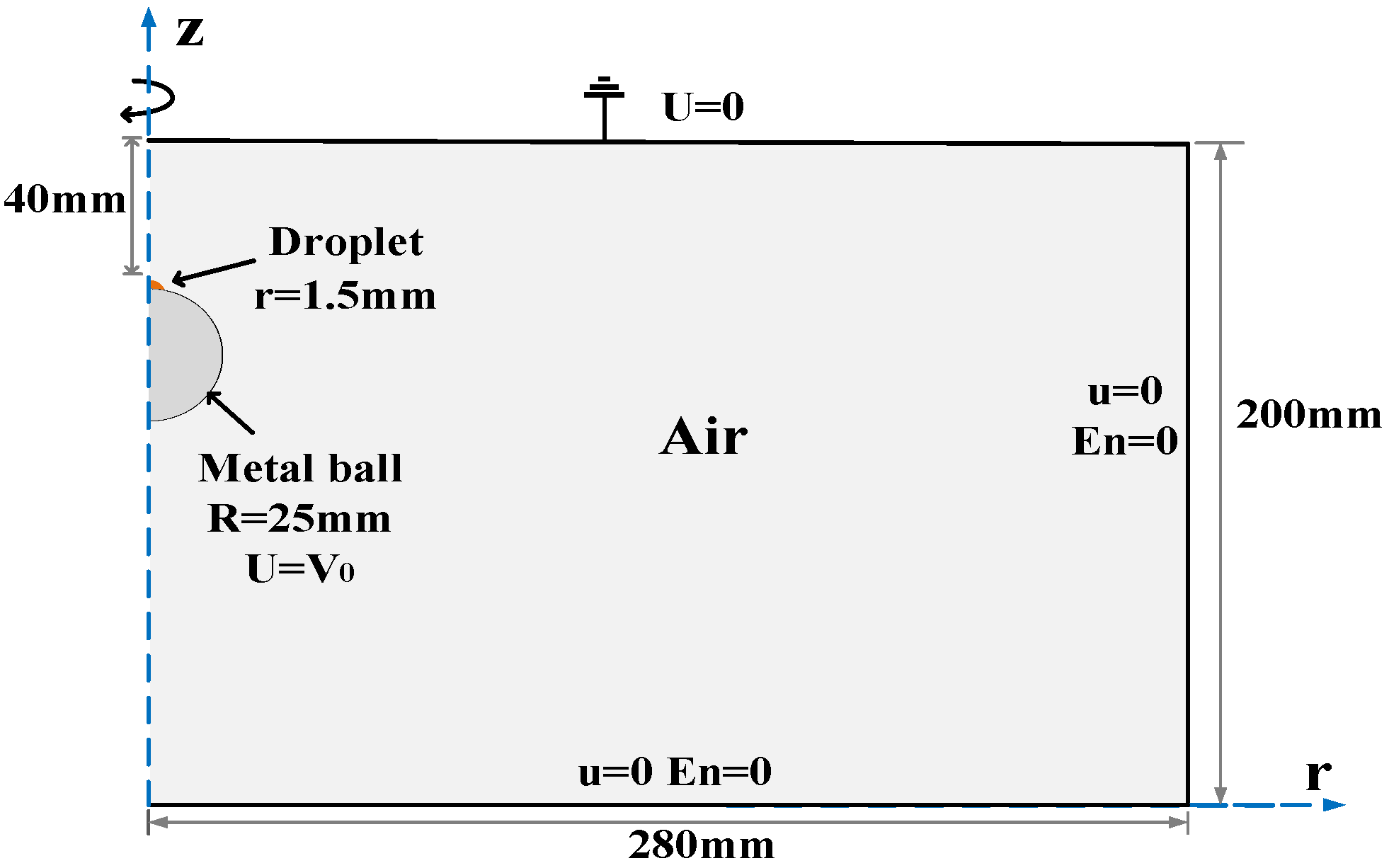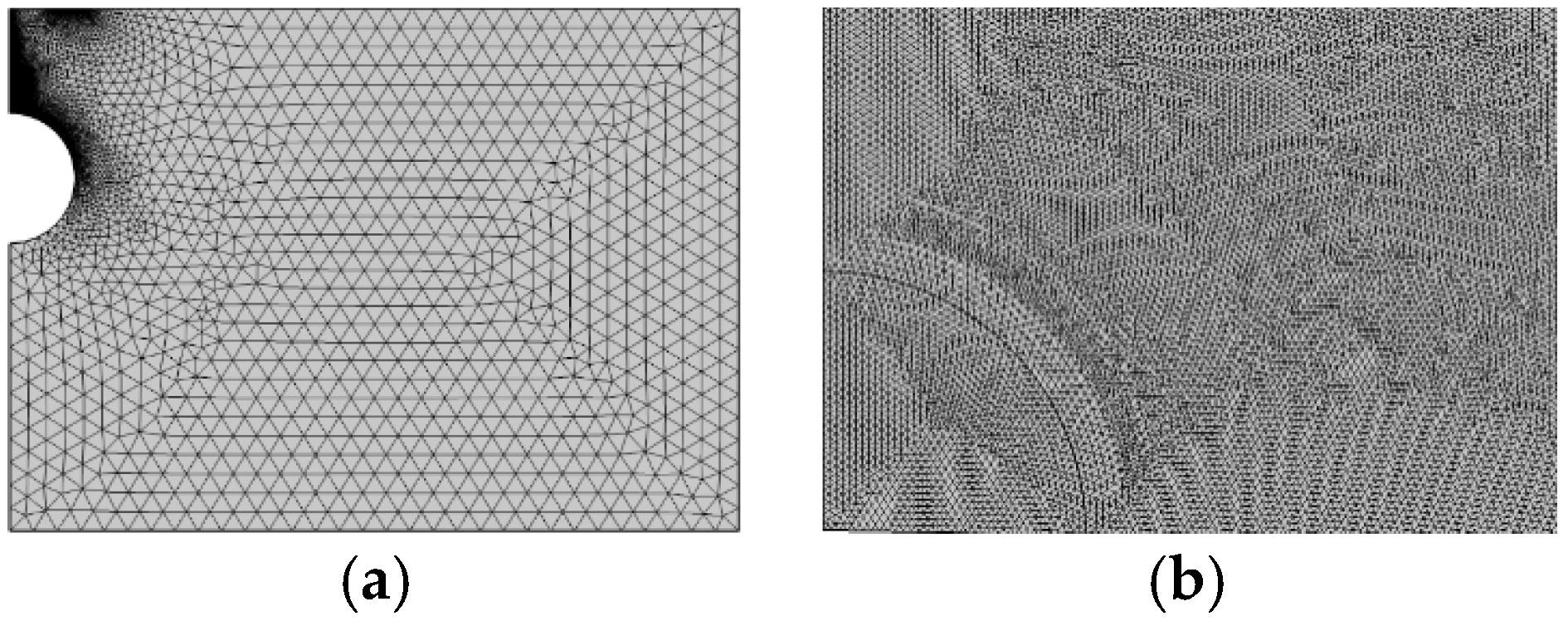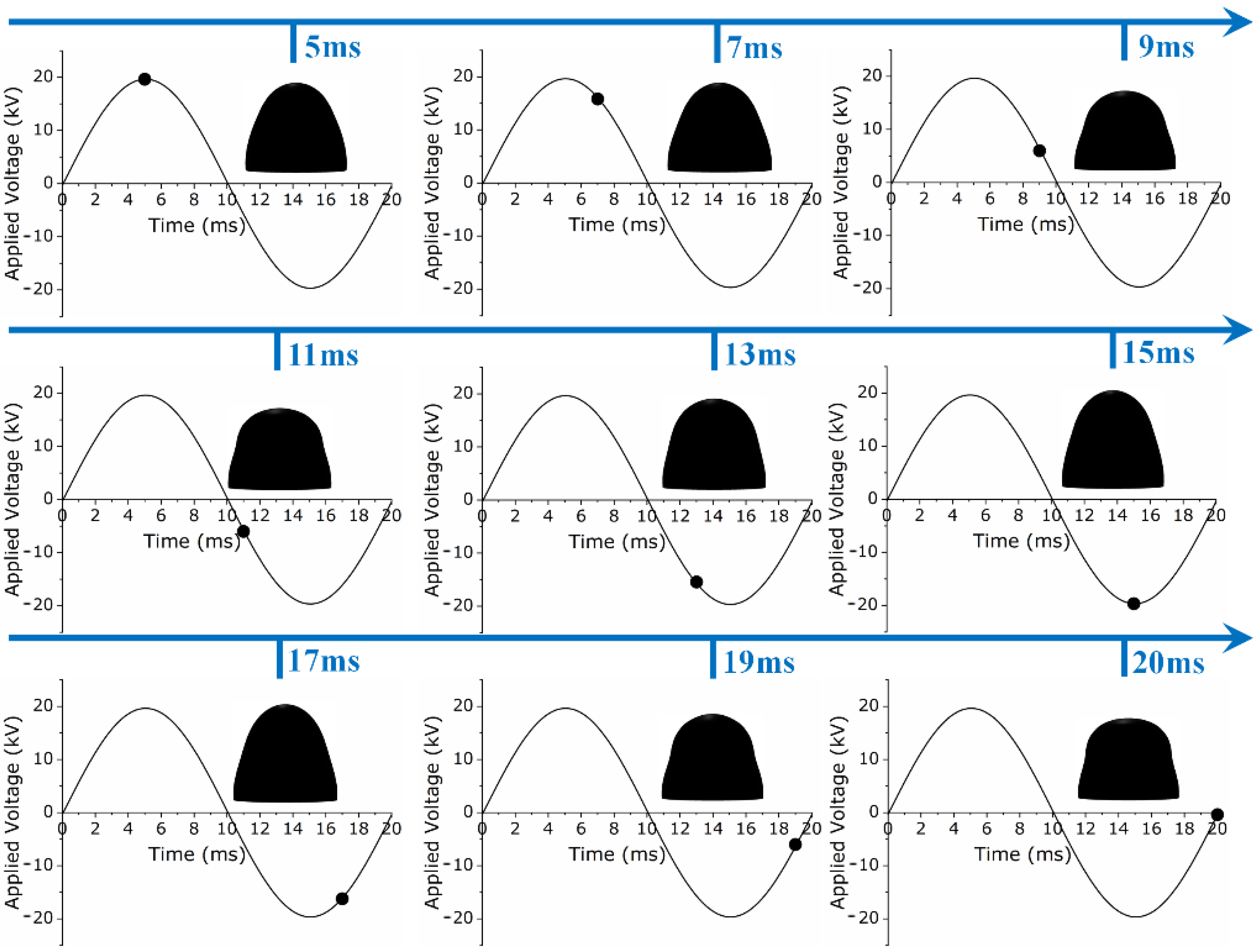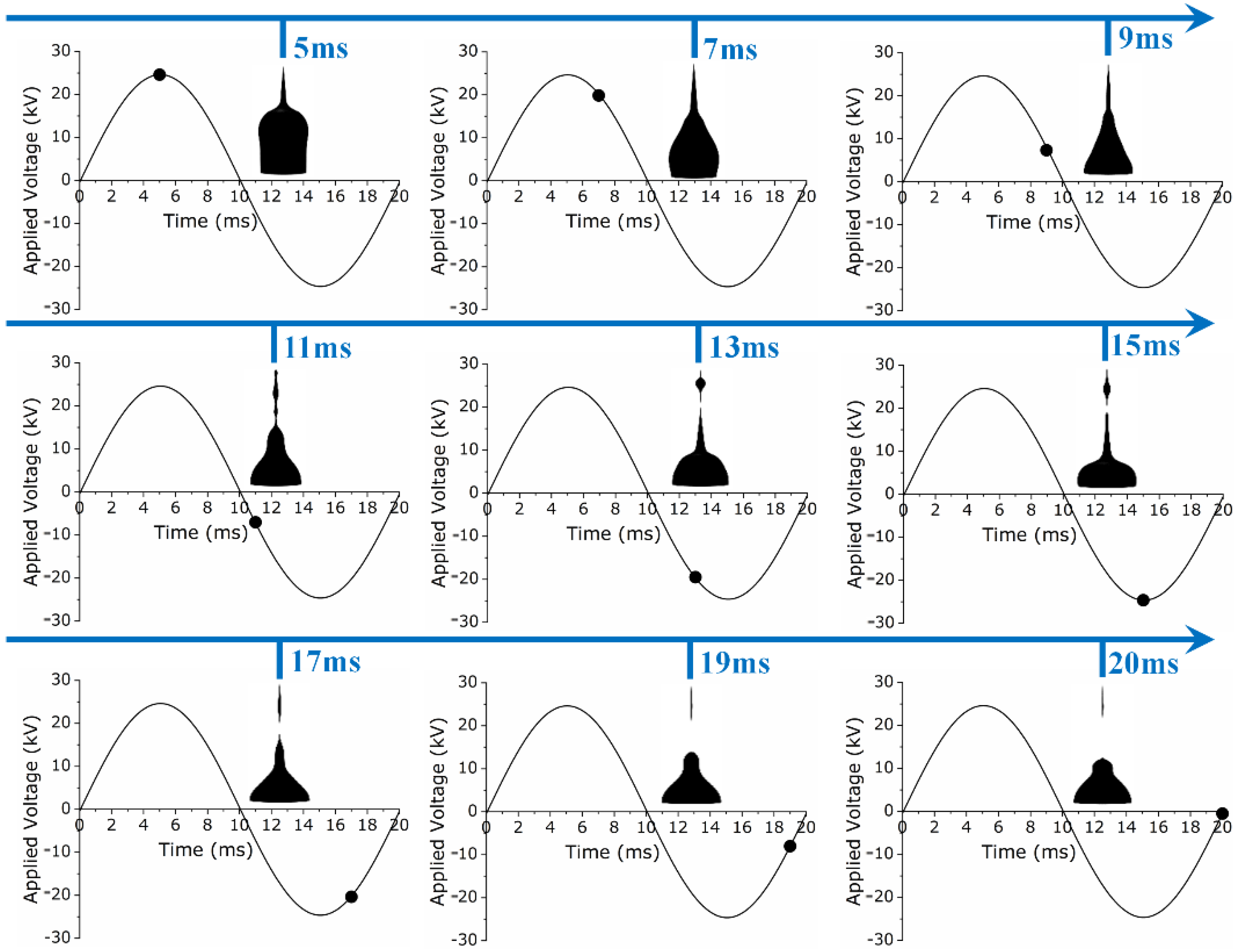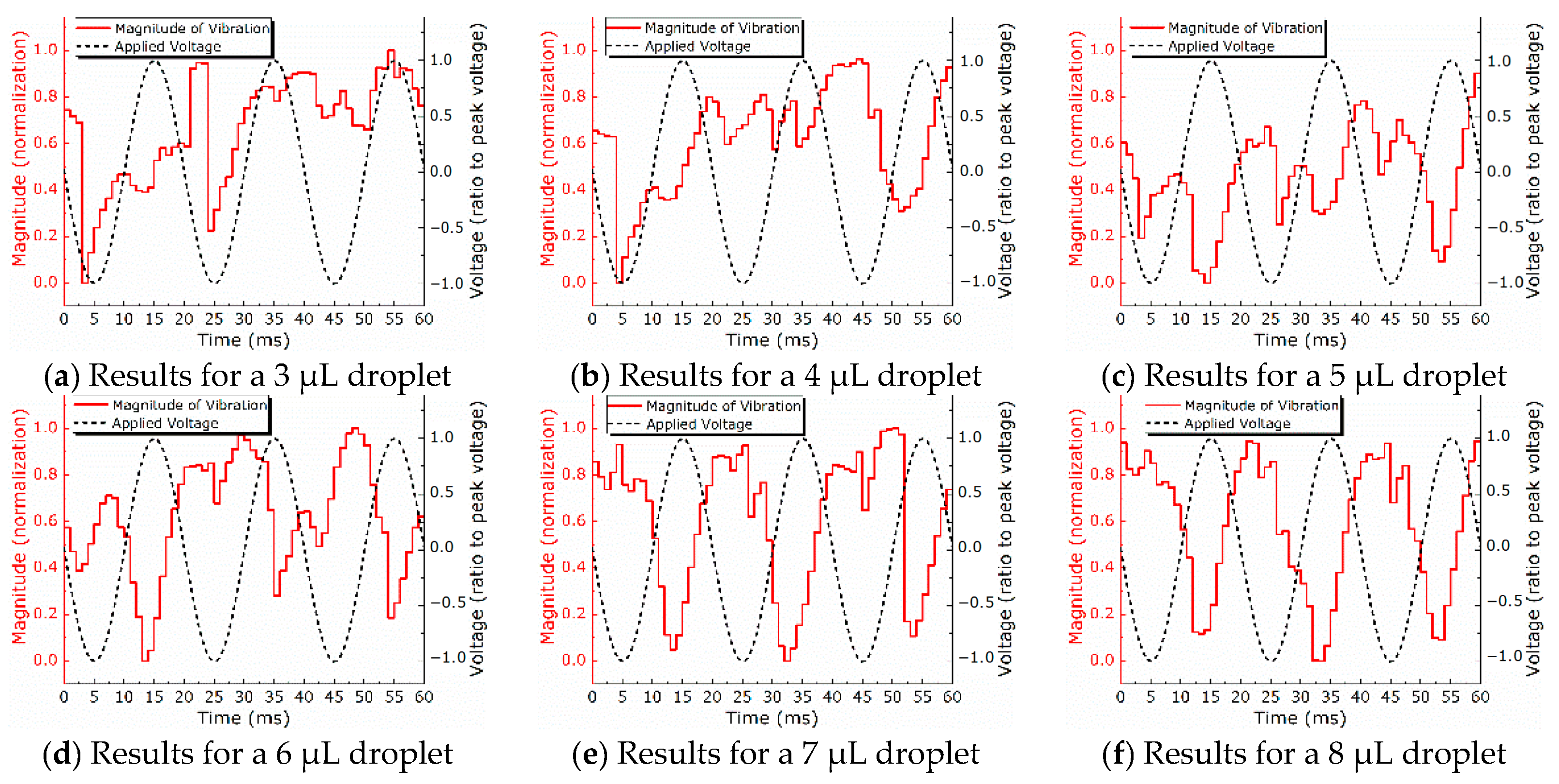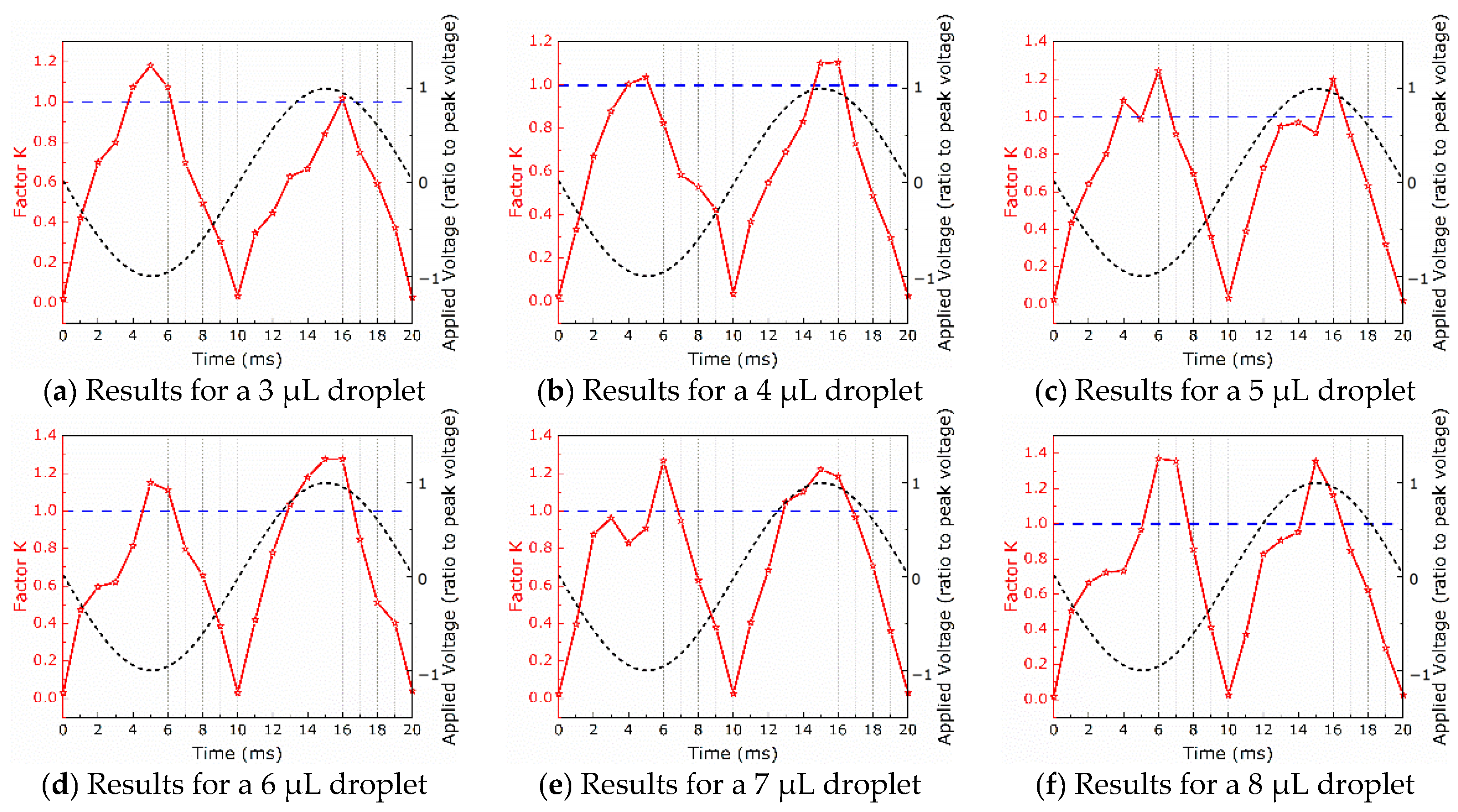1. Introduction
The rain droplets that form on the surface of the OHL conductors are subject to an intensified electric field. The curvature and overall geometry of the protrusion on the surface of the conductor determine the spatial electric field intensity. Macroscopically, protrusions can be classified as solid or liquid, depending on the strength of the intermolecular forces. A water droplet is also a type of protrusion. Compared with solid protrusion whose shape does not vary with time, a water droplet with a vibrating interface makes the electric field computation much more complicated, because the form of liquid is more prone to change. Under the application of electric field, water droplets are subjected to the combined action of electric field force, surface tension, gravity and other forces, resulting in vibration, deformation and crushing. A number of studies have been conducted on the vibration and discharge characteristics of water droplets subject to alternating electric fields either through experiments or simulation [
1].
Through corona cage experiments, researchers found that the morphology of water droplets is the main factor affecting the degree of electric field distortion. Under the same voltage level, to consider the same volume of water droplets, the larger the contact angle of a solid surface, the more serious the distortion that the water droplets will cause of the space electric field [
2]. The field intensity and inception voltage on the surface of the conductor are also related to the number of water droplets on the surface [
3]. In view of the distortion of the surrounding electric field, there are two ways of water droplet rupture during corona discharge: waist fracture and tip spray droplet [
4]. Research on the discharge characteristics of water droplets on the insulator surface mainly focus on the interaction of the electric field between surface droplets, point discharge caused by electric field distortion, and final flashover along a wet surface with the hydrophobic properties of an insulator surface [
5,
6,
7,
8,
9].
Under alternating electric fields, a high-speed camera is an effective device for researchers to observe the motion characteristics of water droplets. Research on the motion characteristics of water droplets on the insulator surface has achieved certain results. Yoshio Higashiyama et al. found that the droplet deforms synchronously with the AC electric field, its resonant frequency is related to the volume of the droplet, and the vibration amplitude largely depends on the frequency and volume of the droplet [
10]. It is proposed that droplet motion from AC voltage action to stable motion or a flashover event can be roughly divided into three categories: transient, irregular and regular motion. Osamu Fujii et al. found that the vibration frequency of uncharged water droplets was twice that of the applied voltage, and the vibration frequency of artificially charged droplets was the same as that of the applied voltage [
11]. Yuan Wei found that the critical stable electric field strength of water droplets on the surface of superhydrophobic coatings was related to the applied electric field strength, the particle size of water droplets, and their surface tension. The Coulomb force applied on the interface of droplets and air had a decisive influence on the electro-induced motion of water droplets [
12]. For the movement characteristics of water on a metal conductor, Qi Li, found that the droplet shape shows a circle change of hemispherical, flat shape and conical cycle changes at twice the power frequency. The phase relationship between applied voltage and droplet vibration depends on the size of the droplet, and the size range of the droplet formed on the conductor surface is the main factor affecting the inception of a corona. Each raindrop has a fixed resonance frequency that makes its vibration amplitude reach its maximum, which is determined by its volume [
13,
14].
Some researchers regard water droplets as spheres in simulation, ignore the influence of electric field on the morphology of water droplets, and only consider the static characteristics of water droplets. For the insulator surface, the field strength near the water droplets will obviously increase. The influence of the position, number, spacing of water droplets and surface contact angle on the surface field strength of silicon rubber was studied [
15,
16]. Researchers also pay attention to the static properties of water droplets on the surface of a transmission line conductor under a strong electric field. It is found that the number of droplets, the surface contact angle and the type of conductors have a great effect on the field strength, among which the influence of the surface contact angle has been paid more attention [
4].
Considering the dynamic characteristics of water droplets, that is, considering the effect of electric field force, research is mainly divided into numerical method and simulation. Research on numerical methods can be traced back to 2003; Dirk et al. proposed the combined fixed solution of a two-dimensional droplet shape and electric field. Then, they further obtained the numerical method of a three-dimensional droplet model under a strong electric field, realizing the simulated deformation motion of droplets under a strong electric field for the first time [
17,
18,
19]. On this basis, the two-dimensional boundary element method [
20], level set method based on finite difference scheme and GFM (ghost fluid method) [
21] appeared successively. According to Debasish Das, previous numerical studies were limited to axisymmetric droplets without considering the interface charge convection. Based on the complete Melcher–Taylor leakage medium model including nonlinear charge convection, a three-dimensional boundary element method was proposed for the EHD of deformable viscous droplets [
22]. Shubhadeep Mandal also found that interfacial charge convection can increase or decrease droplet deformation [
23]. On the basis of the research on droplet deformation, Ghasemi used the Gerris numerical simulation method to further carry out a three-dimensional numerical study on the crushing process of a single droplet under the action of gravity and an electric field [
24].
At present, there are many research studies on the simulation of the dynamic characteristics of water droplets under the electric field, in which the high-voltage electric field is used to promote the aggregation of a water phase and oil phase to separate the water phase. Using the finite element simulation software COMSOL Multiphysics, Wen Liang found that under the uniform electric field, the deformation, fracture and coalescence of water droplets were affected by the electric field strength, oil phase viscosity, interfacial tension and water droplet size, and excessively high electric field strength would make water droplets rupture [
25]. Chunhui Song further found that the deformation, fracture and coalescence of water droplets were greatly affected by the non-uniform coefficient under the non-uniform electric field. An excessively high non-uniform coefficient made it easy for water droplets to crack and reduced the coalescence speed between water droplets [
26]. Recently, based on the phase-field method, Zhiqian Sun simulated the effects of electric field frequency, electric field strength, droplet diameter, surface tension and continuous phase viscosity on the deformation of a single droplet in oil under an alternating current field [
27].
In view of the fact that overhead transmission lines and insulators are in an air medium, the simulation dynamic characteristics of water droplets in an air medium have been studied. Harald Songoro studied the volume and height of water droplets on the insulation board surface with time based on the mobile mesh finite element method, obtaining that the volume error of water droplets was less than 0.15%, and the vibration frequency of water droplets was twice that of the power supply frequency [
28]. Qi Li found similar laws on the surface of the conductor by using the finite element method and further found that the morphology of water droplets on the surface of the metal ball changes in hemispherical, flat and conical cycles [
29]. In recent years, it has been found that the droplet on the insulation board can be divided into part high-frequency vibration and whole left–right fluctuation under the action of power frequency AC, deflect in a certain direction under the action of DC, and then recover [
30]. Mingjie Luan did some related studies and further found that the elongation of water droplets on the surface of silicon rubber insulators increased with the increase of their volume and also significantly increased with the increase of electric field strength [
31].
When a water droplet is under an electric field, the electric field force makes the water droplet move and deform, and the motion and deformation of the water droplet leads to the distortion of the electric field strength, which changes the magnitude of the electric field force. The mutual influence between them is a coupling problem of electricity and fluid dynamics, which is defined as electrohydrodynamics (EHD). In this paper, considering this complex multi-physical field problem of interaction and mutual coupling, starting from the vibration characteristics of water droplets under a strong electric field, Comsol Multiphysics finite element analysis software is employed to study the relationship between the variation trend of electric field intensity and parameters such as the volume size of the water droplet, contact angle between the water droplet and conductor surface, and voltage level. The relationship between the phase and amplitude of the water droplet vibration on the surface of the conductor and the applied voltage is explored so as to reveal the correlativity between the inception mechanism of the corona and the water droplet vibration mechanism.
2. Methodology
In the two-phase flow of gas–liquid, the potential
V of the electrostatic interface satisfies the equation.
where
ε0 is the vacuum dielectric constant, and
εr is the relative dielectric constant.
For the droplet vibration driven by electric field force, the volumetric force is given by the divergence of a Maxwell stress tensor.
The model is established in two-dimensional axisymmetric coordinates, namely a cylindrical coordinate system, and the Maxwell stress tensor can be summarized as follows.
where
E is the electric field strength in all directions, and
Eθ is 0 in the two-dimensional axisymmetric plane; then,
E =
E2r + E2z in the two-dimensional axisymmetry.
Finally, the volume force
F is deduced as follows.
For each fluid, the dielectric constant is different, and the interface shall be defined according to the volume fractions
Vf1 and
Vf2.
where
and
represent the relative dielectric constants of air and water droplets, respectively.
Figure 1 shows the axisymmetric geometry used in the simulation. The droplet radius is 1.5 mm, and it is attached to the surface of the metal ball with a radius of 25 mm. The metal aluminum ball is 40 mm away from the upper plate, the overall height is 200 mm, and the width is 280 mm. The boundary conditions are as follows: the metal aluminum ball is subjected to power frequency AC voltage, and the upper plate is grounded. Neumann conditions
∂φ/
∂n = 0 are set at the bottom and right bounds. For the fluid field, the velocity is 0, all walls are set to no slip, and the outlet is set to constant pressure.
By changing the size of the droplet radius, the vibration characteristics and discharge intensity of droplets with different volume under an electric field are quantitatively studied. At the same time, the vibration and discharge characteristics of water droplets under different electric field intensities are studied accurately by changing the amount of AC voltage applied on the metal sphere.
Three materials, water, air and aluminum, are selected in the model. The material attributes are assigned according to the actual situation, and the attribute parameters are shown in
Table 1.
As is shown in
Table 1, density and dynamic viscosity are required for the fluid module. When studying the dynamic process of the fluid, the metal aluminum ball does not shift. Therefore, it is not necessary to assign values for the dynamic viscosity and density of aluminum material. In this paper, only the motion of water droplets is considered, so there is no need to assign the surface tension coefficient of air and aluminum material.
In this paper, the model is established in two-dimensional axisymmetric geometry in an electrostatic field in a cylindrical coordinate system, which can significantly reduce the problem of three-dimensional simulation calculation. As can be seen from the size of the geometric modeling, the size of the small water drop is very small compared with the metal ball and the plate. If the same partition size is used in the mesh division, it is very inaccurate for the fluid water drop. In order to obtain an accurate gas–liquid interface between air and water droplets, an adaptive meshwork is used, in which the mesh size of small water droplets is treated more stringently. The differences of water droplet meshing will also affect the setting of the above gas–liquid interface thickness parameters. In addition, considering that metallic aluminum spheres are not the object of fluid research, in order to reduce the calculation, the metallic spheres are ignored in mesh division. The overall mesh generation of the model is shown in
Figure 2. The statistical information of overall mesh generation is shown in
Table 2.
A Multi-User-Multi-Processes direct solver is used in this paper. The advantage of the MUMPS algorithm is that it supports partial principal elimination and has higher stability. The result of the direct linear method is more accurate, and the upper triangle and lower triangle matrix of the LU (lower triangular matrices and upper triangular matrices) decomposition matrix can be reused, which saves the time of LU decomposition. This can be set in COMSOL.
3. Results
3.1. Simulation Analysis of Droplet Shape under AC
Considering that the surface contact angle of a typical conductor varies from 75° to 104°, this paper controls the contact angle of droplets on the surface of the metal sphere to 90° without applying an AC electric field. On this basis, the shape changes of an 8 μL droplet under different intensities of an AC electric field are further tested. The droplet volume of 8 μL is for a whole droplet. Periodic movement and top ejection phenomena exist in the shape change of droplets under an AC electric field, as shown in
Figure 3 and
Figure 4. The black oval is a water droplet.
Nine images are selected in
Figure 3 and
Figure 4, respectively, to describe the vibration characteristics of droplets on the surface of metal spheres under the AC electric field. It is found that when a vibrating droplet is not sprayed, the droplet has obvious periodicity, and the vibration frequency is 100 Hz: twice the frequency of the power supply. When a droplet is sprayed, the periodicity of amplitude variation of the droplet is no longer obvious due to the separation of small water droplets, but the vibration frequency is still 100 Hz. The droplet experiences a stretch and compression process within each half-period of 10 ms.
It can also be observed that a conical water column will appear at the top of the droplet when the droplet vibrates under the AC electric field. With the increase of the electric field intensity, part of the water column will separate and produce small spherical droplets. Under the action of electric field force, surface tension and gravity, the shape of small droplets changes further.
3.2. Vibration Characteristics and Applied Electric Field Intensity
Because of the electric field force (volume force), the droplets under an electric field have periodic vibration, tip ejection and waist breakage. Electric field force plays an important role in the process of droplet vibration. In order to study the vibration characteristics of droplets under different electric field forces, the vibration phenomenon of a droplet with a volume of 8 μL under the surface field intensity of a conductor (from 5 to 12 kV/cm) was studied in this paper. The magnitude (top distance between natural state and under the electric field) of droplet vibration under different electric field intensities and the relationship between the instantaneous applied voltage are plotted in
Figure 5.
To observe the phase relationship between the applied voltage and the periodic motion of droplets more clearly, the amplitude of a droplet is normalized here, and the vibration size factor
M (0 <
M < 1) is calculated from:
where
t is time,
L(
t) is the amplitude of the droplet at time
t in the droplet vibration cycle,
L(
t0) is the minimum amplitude of the droplet vibration cycle, and
L(
t1) is the maximum amplitude of the droplet vibration cycle.
3.3. Vibration Characteristics and Droplet Size
The actual droplets attached on the transmission line vary in size. When the size of a droplet alters, the droplet vibration characteristics (especially the droplet amplitude and the phase shift between the input voltage and amplitude) will also change correspondingly due to the change of droplet mass.
Here, different geometric models were utilized for simulation analysis. The droplet sizes of 3, 4, 5, 6, 7 and 8 μL were placed on the surface of the same metal sphere. An accurate power frequency AC voltage was applied on the metal sphere to control the surface effective field intensity of 10 kV/cm without the droplet. The relation between the vibration of a variable-volume droplet and the instantaneous applied voltage is plotted in
Figure 6. The amplitude is normalized in the same way as above.
3.4. Analysis of Space Electric Field Intensity
It is known that the distortion degree of the electric field caused by the droplet in the process of vibration is closely related to the shape of the droplet. To study the influence of droplet shape on the initial electric field, we start from two aspects: droplets under different electric field intensity and droplets with different volume size. Here, the effect of an 8 μL droplet on the original AC electric field intensity (from 8 to 10 kV/cm) is studied, as shown in
Figure 7. Meanwhile,
Figure 8 shows the influence of droplets of variable volumes (from 3 to 8 μL) on the original applied electric field intensity under a 10 kV/cm AC electric field.
An electric field intensity enhancement factor is defined, which is only related to the shape of the droplet and can be calculated from:
where
E(
t)
max is the maximum surface electric field intensity at time
t with a droplet on the surface of the metal ball, and
E0(
t)
max is the maximum surface electric field intensity at time t without a droplet on the surface of the metal ball.
It is found that the droplet attached to the surface of the metal sphere leads to a phase delay between the maximum electric field intensity and applied AC voltage. The reason lies in the change of the droplet’s shape caused by their vibration, which caused the change of electric field intensity and phase.
Figure 7b shows that compared with the lower applied electric field intensity, when the applied AC electric field intensity is 10 kV/cm, the maximum electric field intensity near the droplet changes at a higher rate at the voltage amplitude, indicating that the droplet is in a critical ejection state.
Figure 8b shows that the variation trend of the maximum electric field intensity of a droplet with a jetting phenomenon is different in the positive and negative half-cycle of sinusoidal voltage, revealing that the discharge intensity of a vibrating droplet is different in the positive and negative half-cycle of AC voltage. In addition, the applied electric field strength being constant, the variation trend of the field strength in the droplet vibration period is greatly related to the volume of the droplet.
3.5. Droplet Vibration and Corona Inception
Corona discharge occurs more frequently due to the existence of droplets and the spatial electric field distortion caused by the change of the droplets’ shape. In order to analyze the reason for this phenomenon, the generation of corona discharge with vibrating droplets under an AC field is analyzed.
Here, we define the corona inception factor
K, which can be calculated by the following formula:
where
E(
t) is the space electric field intensity, and
E0 is the critical inception electric field intensity.
As can be seen from the relationship between droplet vibration and the maximum surface electric field, corona discharge will not occur when the applied AC electric field is low. Therefore, here, we mainly discuss the application of an AC electric field to the corona phenomenon caused by droplet vibration.
Figure 9 shows the relationship between the corona inception factor and the instantaneous applied voltage under different droplet volumes.
It is found that:
Under the applied AC electric field, droplets of different sizes have positive and negative corona discharge in a sinusoidal voltage cycle. For small droplets (3 μL), the corona inception voltage of negative corona discharge is significantly lower than that of positive corona discharge. However, for larger droplets (from 5 to 8 μL), there is no significant difference between positive and negative corona voltage.
For a droplet of 3 μL, the corona discharge intensity is larger at a negative sinusoidal voltage half cycle, while for the droplet of 4 μL, the corona discharge intensity is larger at a positive sinusoidal voltage half cycle.
4. Conclusions
By studying the change of droplet shape, it is found that when the applied field intensity exceeds 10 kV/cm, the droplet has the phenomenon of tip ejection. Combining the relationship between the vibration characteristics of droplets under the electric field and the applied voltage, it is concluded that:
When the applied electric field intensity is less than 10 kV/cm, the droplet makes a very obvious periodic vibration, and the maximum and small amplitudes in each period are basically the same. However, when the applied electric field intensity reaches 10 kV/cm or greater, the maximum and small amplitudes of droplets differ greatly in each cycle, which may be caused by the decrease of the mass of the droplet after spraying and the force changes of the whole droplet caused by the falling of small ejected droplets.
The droplet vibration frequency under the electric field is twice that of the power frequency voltage, that is, the droplet vibration frequency is 100 Hz. It is because the high-voltage sinusoidal waveform contains a positive half period and negative half period, and they are mechanically equivalent to droplet vibration.
When the intensity of the applied power-frequency AC electric field increases, there is little change in the phase delay between the vibration amplitude and the applied instantaneous voltage, indicating that when the droplet volume is constant, the phase delay between the vibration amplitude of the droplet and the instantaneous voltage is not related to the intensity of the applied electric field.
The initial cycle amplitude of a droplet under the electric field is significantly higher than that under the natural state without an electric field.
Compared with the vibration result of a fixed volume droplet under different field intensification, the droplet vibration results with relatively stable three voltage cycles, which is different from the previous process directly starting from the pressurization time. It is found that:
The amplitudes of droplets of all volumes under the electric field intensity have abrupt changes, indicating that the spray phenomenon occurs in the process of vibration of the droplets, and smaller water droplets are separated.
Due to the phenomenon of jetting, the amplitude of a droplet varies in different periods.
Even if the droplets under the electric field are sprayed and their mass is decreased, their vibration frequency is still twice that of the applied voltage.
There is a delay between the phase of the vibrating droplet and the phase of the AC voltage under the electric field. The phase of the vibrating droplet lags behind the phase of the applied voltage, and the phase difference becomes larger with the increase of the droplet volume.
The electric field enhancement factor Q changes in different degrees as the form of the vibrating droplet changes. The size of Q is related to the form of the droplet and the instantaneous electric field intensity applied at this time. When the droplet is under a small applied electric field, that is, the vibrating droplet does not spray, the Q of the same volume droplet has roughly the same change trend, and it increases with the increase of the applied AC electric field level.
When the applied electric field (10 kV/cm) is enough to make the vibrating droplet spray, the variation trend of Q is only similar but not identical due to the separation of small droplets. When the vibrating droplet jets, the topological form of the droplet changes. At this time, the amplitude of Q changes greatly, and its size is related to the droplet volume, instantaneous field intensity and droplet form.
Tip ejection of a vibrating droplet occurs at an AC field of 10 kV/cm. With the increase of droplet volume, the amplitude of the corona inception factor K is larger, which makes corona discharge more intense.
With the increase of droplet volume, the range of K which exceeds one in the droplet vibration period becomes larger, because the corona discharge starts from the cone tip for small droplets, while for large droplets, the corona starts from multiple locations on the flat surface.
